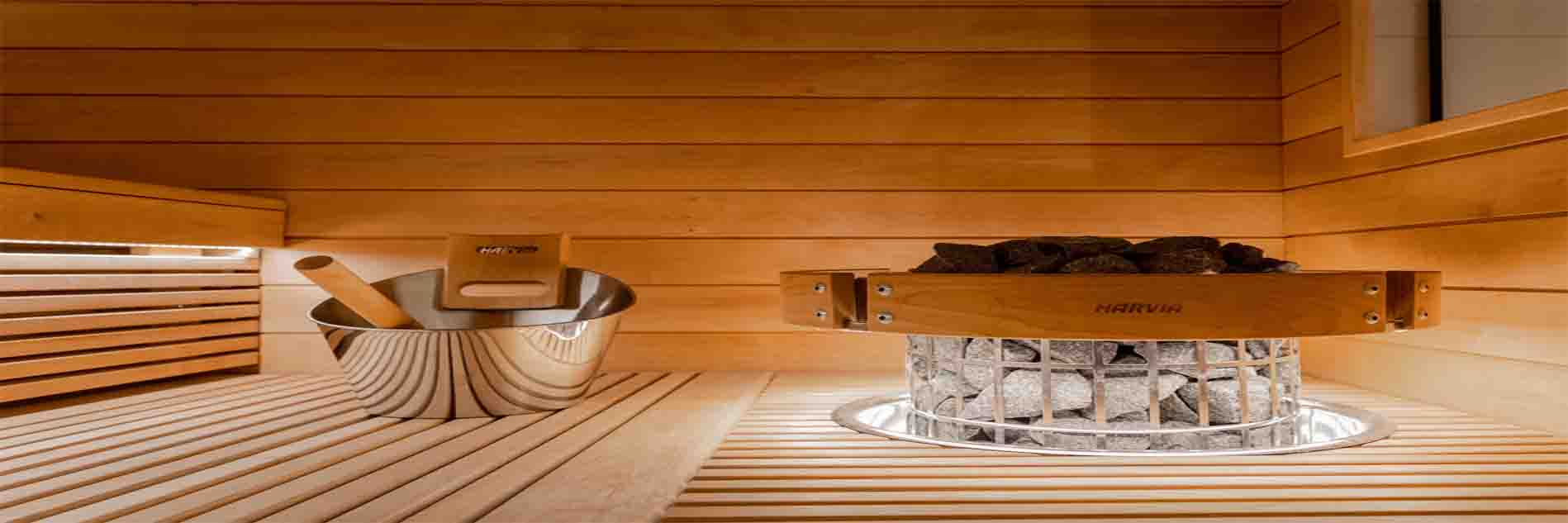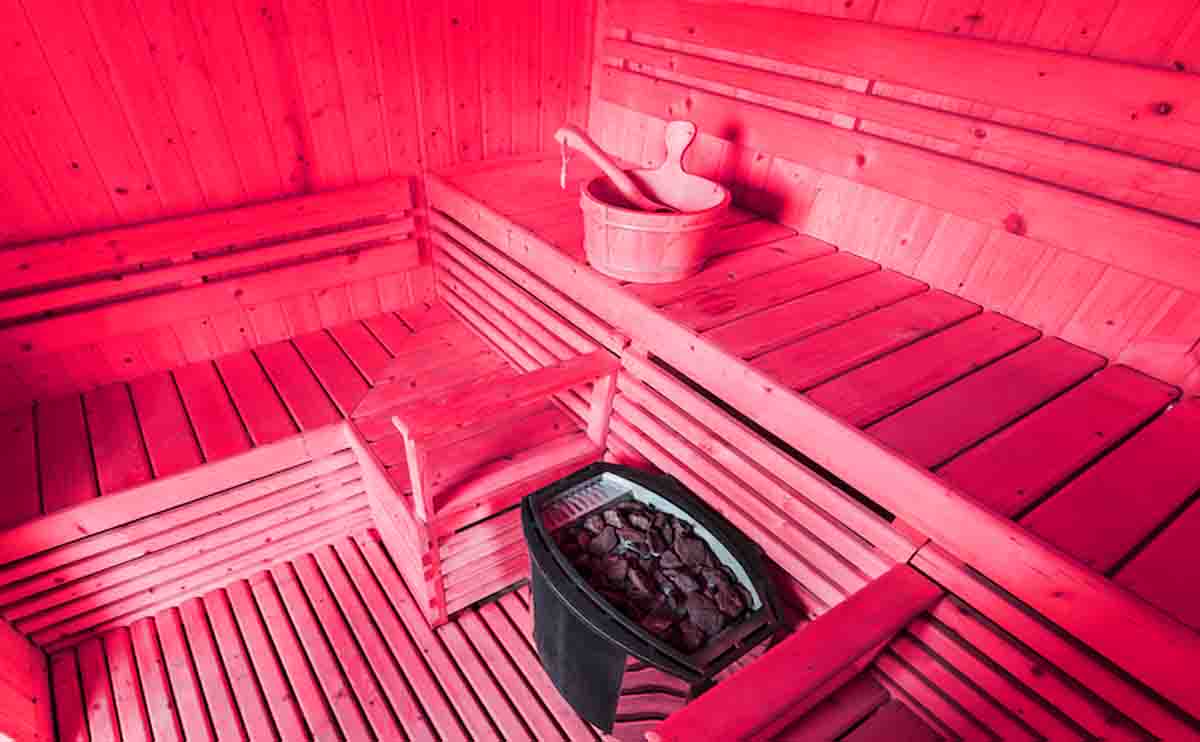The sauna, also known as a dry sauna, has essential health benefits, including skin care, muscle relaxation, and the elimination of toxins, among others.
What is a sauna?
A sauna is a type of sauna that is characterized by its dryness. Unlike other facilities (for example, the steam bath), there is no water or much steam inside the sauna. The humidity is usually around 5-20%, and the temperature it reaches is approximately 80-100 ºC.
These characteristics differentiate it from other types of baths and saunas, such as the following:
- Tropical bath: it has an average temperature of about 50-75 ºC and an ambient humidity of around 20-40%.
- Bio sauna has an average temperature of about 50-60 ºC and an ambient humidity of around 45-65%.
- Russian sauna: in this case, the temperature ranges between 60-90 ºC, and the ambient humidity is around 60-70%.
- Steam bath: in this other case, the temperature hardly reaches 40-45 ºC, although the ambient humidity, compared to the previous ones, increases to 100%.
What are the origins of the sauna?
The sauna has its origins in the Northern European region. Specifically in Finland, Sweden, and Russia. Its original purpose was to help combat low temperatures during the winter, especially cold in that geographical area.
However, over time, it became a relaxing ritual for therapeutic purposes, both for the body and the mind. In addition to becoming a space to socialize, thanks to the significant cultural value that the sauna acquires in the Scandinavian country.
How does the sauna work?
As with the ESSENTIA models, the sauna consists of two essential elements: the structure and the stove.
- Structure: The structure of this type of sauna is made of wood. Its interior is a diaphanous room on whose sides there are continuous benches at various heights. All its covering is made of wood, and, in the center, the stove that heats the structure’s interior is usually located. The floor is made of impregnated solid wood. The floor grill is made in Thermo Magnolia or Thermo Aspen.
- Stove: The stove is the device responsible for heating the sauna, whose internal temperatures can range between 80 and 100 ºC. Currently, stoves can work in different ways. In general, the most common thing is that the furnace has an electrical resistance, which is responsible for heating the stones, which, in turn, are accountable for radiating the heat through the interior of the sauna, and which, it should be noted, is the traditional way of heating this type of saunas.
In this sense, materials are essential to determining what the sauna will be like. It is best to use high-quality wood, such as oak, which helps preserve heat and reach high temperatures without causing any problems.
Likewise, other materials, such as stainless steel or glass, can also be part of the installation of a sauna, with visible fronts that allow you to see the outside through the glass and contribute to the feeling of well-being. At the same time, you enjoy visually open space.
In this type of sauna, the front panel must be made of 8 mm thick transparent tempered glass with a wooden frame. In addition, it is recommended that the door handle be made of stainless steel, and the hinges must have an automatic hydraulic closing system, which is highly recommended for avoiding energy losses.
In short, today, the sauna represents a wellness space that can be adapted and personalized to the taste and needs of each project, as is the case with the ESSENTIA models.
Some of these elements are the following:
- Lighting: Lighting is an essential element when creating environments. In a sauna, you can opt for visible or hidden luminaires, which provide direct or indirect light, white or colored light, among many others.
- Benches: Benches are a fundamental part of the sauna. You can opt for benches made of one type of wood or another, as well as a greater or lesser thickness. In this sense, magnolia wood favors well-being and comfort indoors since it is a plank of wood with low heat conductivity, so the feeling when using the benches is more pleasant. The open benches with common thermal conductivity wood in Thermo Magnolia or Thermo Aspen have a load capacity of up to 200 kg/m.
- Heaters: The heaters are essential to determine the sauna’s style and interior environment. You can choose between different types of heaters and visible or hidden heaters. An example of a good heater is Harvia Virta, a powerful, practical, and styled electric heater that is ideally suited for those who want to enjoy the experience of a traditional sauna.
- Air fresheners: Aroma dispensers help make the sauna experience complete. There is a wide range of fragrances, and they can be adapted to the preferences of the users and the moment.
- Speakers: This is an add-on that further enhances the experience. Thanks to speaker models such as the Sauna speakers, you can install piped music inside the sauna.
- Control panel: The control panel is the touch control unit that provides a modern user interface that is comfortable and perfectly integrated into the sauna. The Harvia Xenio is a control panel that fits all saunas and enhances the user experience.
- Ventilation system: It can perform up to five renewals every hour. The wooden panels are designed with the tongue and groove system to achieve a perfect seal with a temperature resistance of up to 150ºC. In addition, with mineral wool and aluminum foil installation, excellent insulation is completed, both from temperature and humidity.
All of this contributes to making the sauna experience an oasis of peace and well-being, a space to recharge your batteries and purify your body and mind. You might be interested in sauna room suppliers in Dubai.

How to use the sauna: traditional tips
Before entering the sauna, the first thing to do is to take a bath or shower. It should not be forgotten that the purpose of the sauna is not hygiene but treatment. For this reason, the interior of the sauna must be arrived clean.
The interior of the sauna is accessed with a towel. This towel is folded on one of the continuous wooden benches, and the user sits on the towel. This gesture has a double purpose. On the one hand, it prevents the user from burning himself since the wood of the benches is hot, and sitting directly on it can be uncomfortable. On the other hand, it ensures hygiene for other users since it prevents several people from sitting directly on the same surface.
At the same time, although some people prefer to enter the sauna with wet skin, it is best to do it with dry skin. In this way, sweating and the elimination of toxins are favored.
On average, the most common is to stay inside the sauna for around 15 minutes. However, it is not an unalterable custom since some people may only last for 5 or 10 minutes, while others may extend their stay to 25 minutes, but this must be the maximum.
Coming out of the sauna, it is recommended to cool the skin. This can be done in different ways, either by immersing yourself in cold water, entering an ice cabin, or putting ice on top (usually produced by an ice fountain in the wellness center). In both cases, it is best to do it little by little, starting at the feet and gradually ascending. Afterward, you can return to the sauna and repeat the entire process twice.
Benefits of the sauna or dry sauna
Beyond the cultural and social elements, a sauna is a tool with significant benefits for physical and mental health.
- Elimination of toxins and purification of the body: One of the main benefits of the sauna or dry sauna is the elimination of toxins since many toxins in the body are eliminated through sweat. Thanks to the high temperatures of the sauna, the sweating process is activated, and many toxins are eliminated, which contributes to the purification of the body.
- Take care of the skin: In addition to expelling toxins, high temperatures and sweating also contribute to eliminating dead skin cells. In this way, it contributes to cell renewal and skin care.
- Reinforcement of the immune system: By accelerating the elimination of toxins and purification of the organism, it improves the functioning of various body systems, including the immune system.
- Improves breathing: The high temperatures reached inside the sauna or dry sauna help improve the fluidity of mucus. In this way, the expectoration processes are improved, and it helps to expel the excess mucus in the respiratory tract.
- Muscle relaxation: The high temperatures inside the sauna and the cold water baths at the exit contribute to muscle relaxation. Anyone can benefit from this effect. However, it is instrumental after playing sports or after a training session.
- Avoid fluid retention: Excess retained fluids are expelled from sweating and eliminating toxins. In this way, the organism’s better functioning is promoted, contributing to weight loss.
- Reduces stress: Finally, another of the benefits of saunas that cannot be overlooked is that they help to reduce stress significantly. This is achieved thanks to the combined effects of both the elimination of toxins and the muscular relationship, as well as the ritual of the dry sauna itself.
Precautions to be taken
Although the sauna brings essential benefits, a series of precautions must also be taken to guarantee responsible use.
- Water or an infusion should be drunk after using the sauna to compensate for fluid loss.
- On average, staying inside for around 15 minutes per session is best.
- It is recommended not to exceed two full sauna sessions per week.
- People with heart disease should consult their doctor about the advisability of using it.
As you can see, by taking a series of precautions, the sauna becomes an excellent ally for health and well-being. Undoubtedly, a treatment that has many benefits and contributes significantly to users’ physical and mental health.















 Pool Tiles
Pool Tiles



